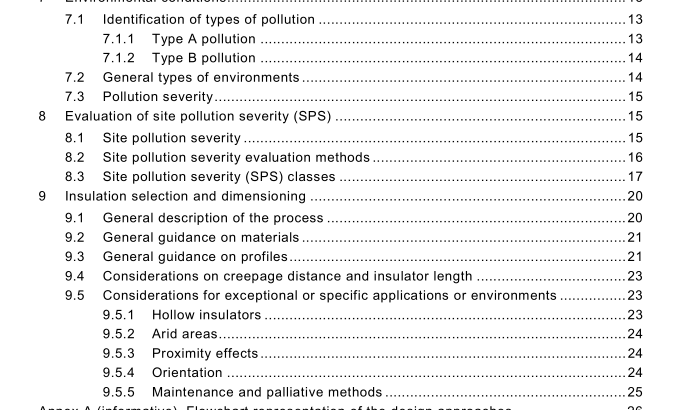IEC 60815-1:2008 pdf download – Selection and dimensioning of high-voltage insulators intended for use in polluted conditions – Part 1: Definitions, information and general principles
Soluble pollution: Soluble pollution is subdivided into high solubility salts (e.g. salts that dissolve readily into water), and low solubility salts (e.g. salts that hardly dissolve). Soluble pollution is measured in terms of an equivalent salt deposit density (ESDD) in mg/cm 2 .
Non-soluble pollution Examples of non-soluble pollution are dust, sand, clay, oils, etc. Non-soluble pollution is measured in terms of non-soluble deposit density (NSDD) in mg/cm 2 . NOTE The influence of the solubility of salts on the pollution withstand voltage is not taken into account in this technical specification and is currently under consideration.
Similarly, the influence of the type of non-soluble pollution is not taken into account. Furthermore, the non-soluble component may contain conductive pollution ( e.g. pollution with metallic conductive particles). Reference [1 ] gives more information on the influence of types of pollutant materials.
7.1.2 Type B pollution
Type B pollution is most often associated with coastal areas where salt water or conductive fog is deposited onto the insulator surface. Other sources of type B pollutions are, for example, crop spraying, chemical mists and acid rain.
7.2 General types of environments For the purposes of this technical specification, environments are described by the following five types. These types describe the typical pollution characteristics for a region. Examples of the type of pollution (A or B according to 7.1 ) are shown in the text. In practice, most polluted environments comprise more than one of these types, for example coastal regions with sandy beaches; in such cases it is important to determine which pollution type (A or B) is dominant.
“Desert” type environments These are areas which are characterized by sandy soils with extended periods of dry conditions. These areas can be extensive. The pollution layer in these areas normally comprises salts that dissolve slowly in combination with a high NSDD level (type A). The insulators are polluted mainly by wind borne pollution. Natural cleaning can occur under the infrequent periods of rain or by “sand blasting” during strong wind conditions. Infrequent rain, combined with the slow dissolving salts in this type of pollution, causes natural cleaning to be less effective. Critical wetting, which poses a risk for insulator flashover, can occur relatively frequently in the form of dew on the insulators.
“Coastal” type environments These areas are typically in the direct vicinity of the coast, but in some cases, depending on topography, they can be as far as 50 km inland. Pollution is deposited onto the insulators mainly by spray, wind and fog. The pollution build-up is generally rapid, especially during spray or conductive fog conditions (type B). A build-up of pollution over a longer term can also occur through a deposit of wind-borne particles, where the pollution layer on the insulators consists of quick dissolving salts with a degree of inert component (type A) which depends on the local ground characteristics. Natural cleaning of the insulators is typically effective as the active pollution consists mainly of fast dissolving salts
“Industrial” type environments These are areas located in close proximity to an industrial pollution source, and may affect only a few installations. The pollution layer may constitute conductive particulate pollution, such as coal, metallic deposits; or dissolved gasses, such as NOx, SOx (type B); or pollution that dissolves slowly, such as cement, gypsum (type A). The pollution layer may have a medium to high inert component (medium to high NSDD) (type A). The effectiveness of natural cleaning in industrial areas can vary greatly depending on the type of pollution present. The pollution is often heavy particles which settle on horizontal surfaces.
